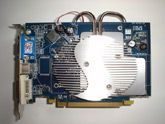Sapphire Ultimate X1600 Pro and X1600 XT
|
|
|
 Sapphire X1600 Pro |
 Sapphire X1600 Pro |
 Sapphire X1600 XT |
 Sapphire X1600 XT |
At first glance, your eyes will be drawn to the custom cooler Sapphire has designed for their cards. The large aluminum heatsink covers both sides of the PCB, and uses heatpipe technology to help enhance cooling. Thanks to the heatpipes, and the large surface area of the cooler, Sapphire was able to use a low-RPM fan on their cards, so noise won't be a problem for most people. The Sapphire X1600 Pro uses GDDR2 memory, while the X1600 XT uses GDDR3 memory to achieve much higher memory speeds. Both types of ram run considerably cooler than standard DDR. The only advantage over Sapphire's Ultimate X1600 series and Sapphire's other X1600 series is the heatsink design, which provides better cooling and less noise.
The X1600 Pro and X1600 XT and their respective packages are nearly identical. The only difference being the type of memory used, and the clock speeds of the two cards. Sapphire's X1600 Pro runs at 500MHz/800MHz, while the X1600 XT runs at 578MHz/1.38GHz. There's quite a big difference in memory speeds, so the performance should be interesting to see once the benchmarks start. The cards are outfitted with 1xVGA, 1xDVI, and 1xComposite Video.
Sapphire includes a DVI to VGA adapter with each of their products though, so those of you with dual VGA monitors will be all set. Inside you'll find a CD containing all the necessary drivers to get your card up and running. Sapphire has also included an S-Video cable, Composite video cable, an S-Video to Composite video adapter, S-Video to component output adapter, and an DVI to VGA adapter.
|
|
|
Sapphire's new heatsink design is effective and aesthetically pleasing. The large heatsink on the front of the card makes direct contact with the GPU, and has no fan. Heat is transferred through the pipes to the back of the card, where the heat is dispersed with the help of a small and quiet fan. The shear size of the cooler adds some weight to the card, but not enough weight to damage the card if you were to accidently knock over your case. We'd also have no fears installing this into a ventilated HTPC enclosure, it really seems to be a well made heatsink.











